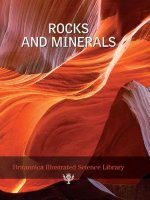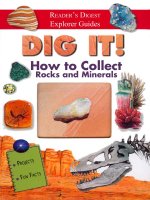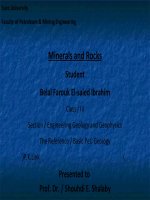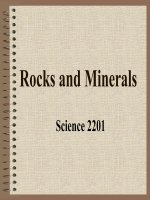rocks minerals 06
Bạn đang xem bản rút gọn của tài liệu. Xem và tải ngay bản đầy đủ của tài liệu tại đây (3.33 MB, 33 trang )
Rocks and Minerals
• Atoms, Elements, Isotopes, Ions, and
Compounds
• Minerals–General
• Types of Minerals
• Rocks
Minerals- the building blocks
•
•
•
•
Atomic Structure
Elements and Isotopes
Ions
Compounds
Rocks and Minerals
• Minerals Defined
• Identifying Characteristics of Minerals
• Other Physical Properties of Minerals
Halite Crystal
Source: Photograph © The McGraw-Hill Companies, Inc./Bob Coyle, photographer.
Galena
Source: Photograph © The McGraw-Hill Companies, Inc./Doug Sherman, photographer.
Fluorite
Source: Photograph © The McGraw-Hill Companies, Inc./Doug Sherman, photographer.
Halite
Source: Photograph © The McGraw-Hill Companies, Inc./Doug Sherman, photographer.
Definition of a Mineral
“A naturally occurring, inorganic, solid
element or compound with a definite
chemical composition and a regular
internal crystal structure.”
Mineral Characteristics
• Chemical composition
– Diamond = graphite (both are pure carbon)
• Crystal structure
– Diamond ≠ graphite
Cubic Structure of Halite
Source: Photograph © The McGraw-Hill Companies, Inc./Bob Coyle, photographer.
Mineral Properties
• Hardness (Mohs hardness scale)
– See appendix C
• Cleavage (how it breaks- atomic scale)
• Luster- the surface ‘sheen’
• Color is not a good property for i.d.
– Corundum (Al2O3)
Minerals: two groups
• Silicates (Si + O ± other elements)
–
–
–
–
–
–
–
All built with ‘silicon tetrahedra’
4 O atoms, 1 Si atom, 4- charge
Quartz, feldspars
Olivine (peridot) ferromagnesian (Fe, Mg)
Asbestos
Micas
Clays (tropical weathering)
Minerals: non-silicates
• Nonsilicates
Example
– Carbonates (CO3):
calcite
– Sulfates (SO4):
gypsum
– Sulfides (metal + S):
pyrite
– Oxides (metal + O):
hematite
– Hydroxides (metal + OH):
gibbsite
– Halides (metal + halide): salt (halite)
– Native elements
Au, Ag, Pt, Cu, C
Rocks
•
•
•
•
•
The Rock Cycle
Igneous Rocks
Sediments and Sedimentary Rocks
Metamorphic Rocks
The Rock Cycle Revisited
Definition of a Rock
• A solid, cohesive aggregate of one or
more minerals or mineral materials
• Important for construction
• Geologic history
The Rock Cycle
• Earth as a constantly changing system
• Plate tectonics
• 3 types of rocks on Earth
– Igneous
– Sedimentary
– Metamorphic
The Rock Cycle
• Igneous Rocks
–
–
–
–
Formed by the crystallization of magma
Usually made up of silicate minerals
Plutonic: solidified inside Earth (granite)
Volcanic: solidified on Earths surface (lava)
Granite, a Plutonic
Rock
Source: Courtesy of Carla W. Montgomery.
Obsidian,
Volcanic
Glass
Source: Photograph © The McGraw-Hill Companies, Inc./Bob Coyle, photographer.
Basalt, a Volcanic
Rock
Source:Courtesy of Carla W. Montgomery.
Porphyry, an
Igneous Rock
Source: Photograph © The McGraw-Hill Companies, Inc./Bob Coyle, photographer.
The Rock Cycle
• Sedimentary Rocks
– Chemical precipitation
• Limestone (carbonate), chert
– Clastic sedimentation
• Sandstone, shale, conglomerate
Limestone
Source: Photograph by I.J. W itkind, USGS Photo Library, Denver, CO.









